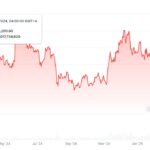February proved to be a challenging month for the cryptocurrency market, as trading volumes took a significant hit due to rising concerns over potential tariffs imposed by the Trump administration. These tariffs, affecting key trading partners like Mexico, Canada, and others, have led to a bearish sentiment among investors, who seem increasingly wary of adding risky investments amid fears of stunted international trade. According to CoinDesk Data’s latest Exchange Review, combined spot and derivatives trading volume on centralized exchanges dropped by 21%, totaling a striking .2 trillion—the lowest level recorded since October.
Among the leading exchanges, Binance held its ground as the top spot trading platform with a commanding 27% market share, while competitors like Crypto.com and Bybit followed with shares of 8.1% and 7.4%, respectively. Coinbase and MEXC Global rounded out the top five, but all platforms felt the pressure from diminishing trading activity.
The decline was not limited to spot trading; derivatives markets also experienced a downturn. CME, the largest institutional venue for crypto, recorded its first volume drop in five months. Trading on this platform fell 20%, bringing the total to 9 billion, with notable reductions in bitcoin futures—which dropped to 5 billion—and ether futures, which fell to .9 billion, down 13%.
Interestingly, even as overall trading volume declined, CME’s market share for derivatives exchanges climbed to a record 4.67%. This indicates that while retail trading appears to be on the decline—illustrated by Robinhood’s 29% dip in crypto trading volume—there remains a sustained interest from institutional investors in the cryptocurrency sector.
Additionally, total open interest across all trading pairs on centralized exchanges fell by 30%, reaching .8 billion, the lowest since November 5. This decline reflects the considerable liquidations that traders have faced amidst the recent market adjustments, highlighting the volatility still present in the crypto landscape.

Impact of February Crypto Trading Volume Decline
The sharp drop in crypto trading volumes in February indicates significant concerns in the market, primarily attributed to increasing trade tensions and tariffs imposed by the Trump administration. This situation could have various implications for investors and the overall economic landscape.
- Significant Decrease in Trading Volume:
- Combined spot and derivatives trading volume on centralized exchanges decreased by 21% to .2 trillion, the lowest since October.
- CME, the largest institutional trading venue, experienced a 20% drop in trading volume.
- Market Reaction to Tariffs:
- Concerns over President Trump’s tariffs on trading partners like Mexico and Canada have stifled investor confidence.
- This uncertainty reduces demand for riskier investments, impacting market dynamics.
- Centralized Exchange Market Share:
- Binance retained its position as the largest spot trading platform with a 27% market share.
- Crypto.com and Bybit followed, indicating competitive trading environments among centralized exchanges.
- Institutional Interest vs. Retail Activity:
- Despite a decline in retail trading (e.g., Robinhood reported a 29% drop), institutional interest seems to be holding steady.
- The CME’s market share in derivatives rose to a record 4.67%, signaling a shift in trading activity focus from retail to institutional investors.
- Implications for Future Trading:
- Falling total open interest across trading pairs reflects reduced liquidity and could pressure prices further.
- Investors may need to reassess their strategies in light of ongoing global trade tensions and market instability.
The impacts of regulatory actions and trade conflicts highlight the interconnectedness of global markets and the importance of staying informed for investors seeking to navigate uncertainty.
Crypto Trading Volumes Take a Hit Amid Tariff Concerns
The recent report regarding the significant decline in crypto trading volumes has raised eyebrows in the finance community. February saw a sharp 21% drop to .2 trillion in combined spot and derivatives trading on centralized exchanges. This downturn aligns with increasing apprehensions surrounding President Trump’s tariffs on trading partners, which many believe could hinder global trade and subsequently dampen investor sentiment toward riskier assets.
When comparing this news to similar trends in the market, Binance continues to showcase resilience, retaining its title as the largest spot trading platform with a noteworthy 27% market share. This steadfast performance indicates Binance’s strong brand equity and operational capacity to absorb market fluctuations better than its competitors like Crypto.com and Bybit. On the other hand, traditional platforms like CME are feeling the pinch, evidenced by their first volume drop in five months and a stark 20% reduction in bitcoin futures trading. This situation raises questions about the impacts of external economic policies on crypto derivatives markets.
On the one hand, retail investors may be deterred by these growing uncertainties, as showcased by Robinhood’s alarming 29% decline in crypto trading volumes. Such a scenario could potentially limit access to emerging crypto opportunities for everyday investors, thereby affecting overall participation in the market. Conversely, institutional investors may perceive this environment as a competitive advantage, potentially leading to strategic accumulation at lower price points. The paradox of declining retail participation alongside rising institutional interest highlights a significant shift in market dynamics that could reshape the industry’s future landscape.
Overall, while market leaders like Binance might navigate these turbulent times efficiently, smaller exchanges and retail platforms could face significant challenges. Investors, particularly those engaging in speculative trading, may find themselves at a crossroads, weighing their options in a climate marred by regulatory uncertainties and economic volatility. In this phase, strategic decision-making will be crucial, as opportunities amid adversity might not be accessible for all.

















